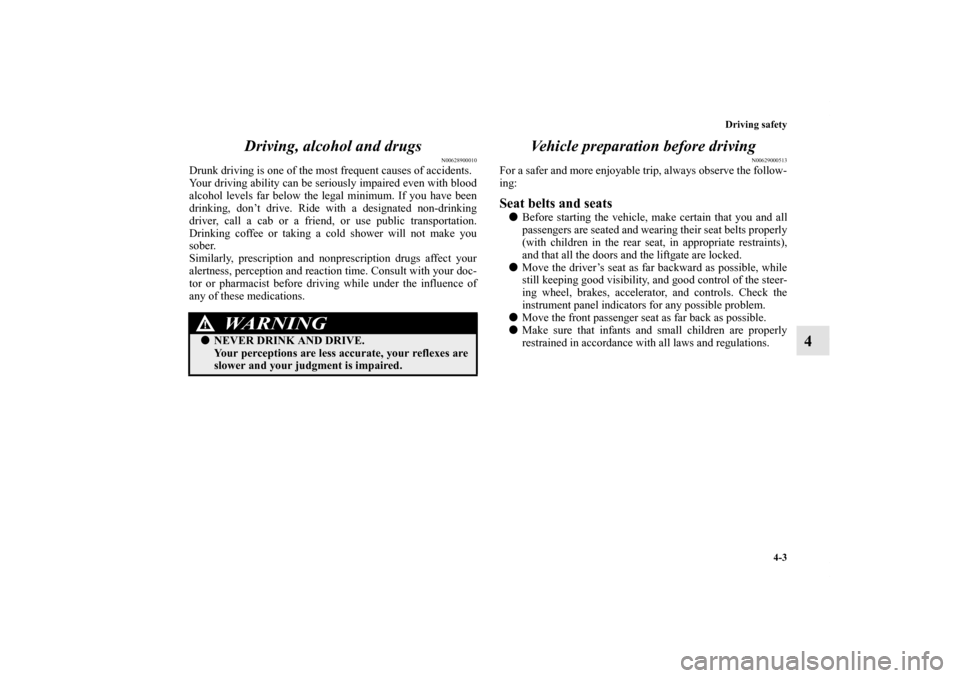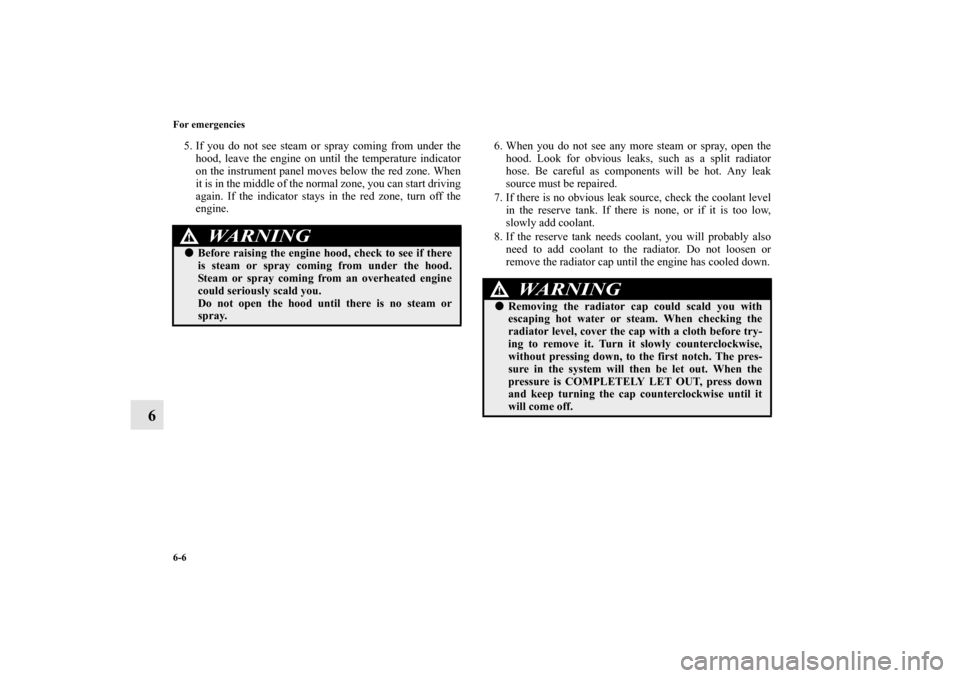Page 246 of 514

Features and controls
3-157
3 Turn signal lever
N00522600027
When changing lanes, or making a gradual turn, hold the lever
in the “lane change” position (1). It will return to the neutral
position when you let go. Use the full position (2) when mak-
ing a normal turn. The lever will return to the neutral position
when the turn is complete. There may be times when the lever
does not return to the neutral position. This usually happens
when the steering wheel is turned only slightly. You can easily
return the lever by hand.
NOTE�A light in the instrument panel flashes to show when the
front and rear turn signal lights are working properly.
If this light flashes faster than usual, check for a burned
out lamp bulb or malfunctioning connection.
If the panel light does not come on when the lever is
moved, check for a blown fuse or a burned out bulb in the
panel.
Have the vehicle inspected by an authorized Mitsubishi
dealer or a repair facility of your choice.
�In a vehicle with a multi center display, the multi center
display can be used to select whether the tone will sound
or not sound when the hazard warning flashers are acti-
vated. For details, refer to “Setting and customization” on
page 3-108.
BK0102600US.book 157 ページ 2009年3月30日 月曜日 午後2時2分
Page 248 of 514
Features and controls
3-159
3 Instrument panel light dimmer control
N00522900121
The brightness of the instrument panel lights can be adjusted
by turning this control while the light switch is in the “ ” or
“ ” position. NOTE�It is possible to disable the function that adjusts the bright-
ness of the multi center display in synchronization with
the instrument panel light dimmer control. For details,
refer to “Setting and customization” on page 3-108.
Wiper and washer switch
N00523000392
Windshield wipersThe windshield wipers wipe when the wiper lever is moved as
shown in the illustration and the ignition key is in the “ON” or
“ACC” position.
1- Bright
2- Dark
MIST- Misting function
The wipers will wipe one time
OFF- Off
INT- Speed sensitive intermittent operation
Interval between wiper sweeps varies in accordance with
vehicle speed.
LO- Slow
HI- Fast
BK0102600US.book 159 ページ 2009年3月30日 月曜日 午後2時2分
Page 302 of 514

Driving safety
4-3
4 Driving, alcohol and drugs
N00628900010
Drunk driving is one of the most frequent causes of accidents.
Your driving ability can be seriously impaired even with blood
alcohol levels far below the legal minimum. If you have been
drinking, don’t drive. Ride with a designated non-drinking
driver, call a cab or a friend, or use public transportation.
Drinking coffee or taking a cold shower will not make you
sober.
Similarly, prescription and nonprescription drugs affect your
alertness, perception and reaction time. Consult with your doc-
tor or pharmacist before driving while under the influence of
any of these medications.
Vehicle preparation before driving
N00629000513
For a safer and more enjoyable trip, always observe the follow-
ing: Seat belts and seats�Before starting the vehicle, make certain that you and all
passengers are seated and wearing their seat belts properly
(with children in the rear seat, in appropriate restraints),
and that all the doors and the liftgate are locked.
�Move the driver’s seat as far backward as possible, while
still keeping good visibility, and good control of the steer-
ing wheel, brakes, accelerator, and controls. Check the
instrument panel indicators for any possible problem.
�Move the front passenger seat as far back as possible.
�Make sure that infants and small children are properly
restrained in accordance with all laws and regulations.
WA R N I N G
!�NEVER DRINK AND DRIVE.
Your perceptions are less accurate, your reflexes are
slower and your judgment is impaired.
BK0102600US.book 3 ページ 2009年3月30日 月曜日 午後2時2分
Page 303 of 514

4-4 Driving safety
4
Floor mats Defrosters
Check these by selecting the defroster mode, and set the blower
switch on high. You should be able to feel the air blowing
against the windshield.
(Refer to “Defrosting or defogging the windshield and door
windows” on page 5-12, 5-23.)TiresCheck all the tires for heavy tread wear or uneven wear pat-
terns. Look for stones, nails, glass, or other objects stuck in the
tread. Look for any tread cuts or sidewall cracks. Check the
wheel nuts for tightness, and the tires (including spare tire) for
proper pressures. Replace your tires before they are heavily
worn out.
As your vehicle is equipped with a tire pressure monitoring
system, there is a risk of damage to the tire inflation pressure
sensors when the tire is replaced on the rim. Tire replacement
should, therefore, be performed only by an authorized Mitsub-
ishi Motors dealer.LightsHave someone watch while you turn all the exterior lights on
and off. Also check the turn signal indicators and high-beam
indicators on the instrument panel. Fluid leaksCheck the ground under the vehicle after parking overnight, for
fuel, water, oil, or other leaks. Make sure all the fluid levels are
correct. Also, if you can smell fuel, you need to find out why
immediately and have it fixed.
WA R N I N G
!�Keep floor mats clear of the pedals by correctly lay-
ing floor mats that are suitable for the vehicle.
To prevent the floor mats from slipping out position,
securely retain them using the hooks etc.
Note that laying a floor mat over a pedal or laying
one floor mat on top of another can obstruct pedal
operation and lead to a serious accident.
BK0102600US.book 4 ページ 2009年3月30日 月曜日 午後2時2分
Page 321 of 514
5-2 Comfort controls
5Ve n t s
N00729900092
NOTE�Do not place beverages on top of the instrument panel. If
they splash into the air conditioning vents, they could
damage the system.
Air flow and direction adjustments
N00730200271
Center ventsAdjust the horizontal direction of the air flow by turning the
dial (A).
The vent can be opened and closed with the dial (A).
Adjust the vertical direction of the air flow by turning the dial
(B).
1- Center vents
2- Side vents
3- Rear vents (for vehicles with automatic air conditioning)
Left side Right side
Open
CloseOpen
Close
BK0102600US.book 2 ページ 2009年3月30日 月曜日 午後2時2分
Page 405 of 514

6-6 For emergencies
6
5. If you do not see steam or spray coming from under the
hood, leave the engine on until the temperature indicator
on the instrument panel moves below the red zone. When
it is in the middle of the normal zone, you can start driving
again. If the indicator stays in the red zone, turn off the
engine.6. When you do not see any more steam or spray, open the
hood. Look for obvious leaks, such as a split radiator
hose. Be careful as components will be hot. Any leak
source must be repaired.
7. If there is no obvious leak source, check the coolant level
in the reserve tank. If there is none, or if it is too low,
slowly add coolant.
8. If the reserve tank needs coolant, you will probably also
need to add coolant to the radiator. Do not loosen or
remove the radiator cap until the engine has cooled down.
WA R N I N G
!�Before raising the engine hood, check to see if there
is steam or spray coming from under the hood.
Steam or spray coming from an overheated engine
could seriously scald you.
Do not open the hood until there is no steam or
spray.
WA R N I N G
!�Removing the radiator cap could scald you with
escaping hot water or steam. When checking the
radiator level, cover the cap with a cloth before try-
ing to remove it. Turn it slowly counterclockwise,
without pressing down, to the first notch. The pres-
sure in the system will then be let out. When the
pressure is COMPLETELY LET OUT, press down
and keep turning the cap counterclockwise until it
will come off.
BK0102600US.book 6 ページ 2009年3月30日 月曜日 午後2時2分
Page 431 of 514
7-4 Vehicle care and maintenance
7Engine hood
N00937500389
To openUse the engine hood release lever (located under the instrument
panel near the driver’s door) to unlock the engine hood.
Pull the lever toward you to release the engine hood latch.Release the safety lever and lift the engine hood.
NOTE�To prevent damage to the engine hood and wipers, make
sure the wipers are at resting position when you open the
engine hood.
WA R N I N G
!�Never use the release lever to unlatch the engine
hood while the vehicle is in motion. �Do not drive your vehicle unless the engine hood is
locked.
BK0102600US.book 4 ページ 2009年3月30日 月曜日 午後2時2分
Page 465 of 514
7-38 Vehicle care and maintenance
7
Ty p e B
1. Pull the lock lever.
2. Open the cover.Fuse load capacities This fuse list shows the names of the electrical systems and
their fuse capacities.
There are spare fuses in the cover of the instrument panel
(driver’s side). Always replace a blown fuse with one of the
same capacity as the original.
WA R N I N G
!�Do not touch the electronic control module (C). The
module surface can be too hot.
Wait for the electronic control module to cool down
before replacing a fuse.
BK0102600US.book 38 ページ 2009年3月30日 月曜日 午後2時2分